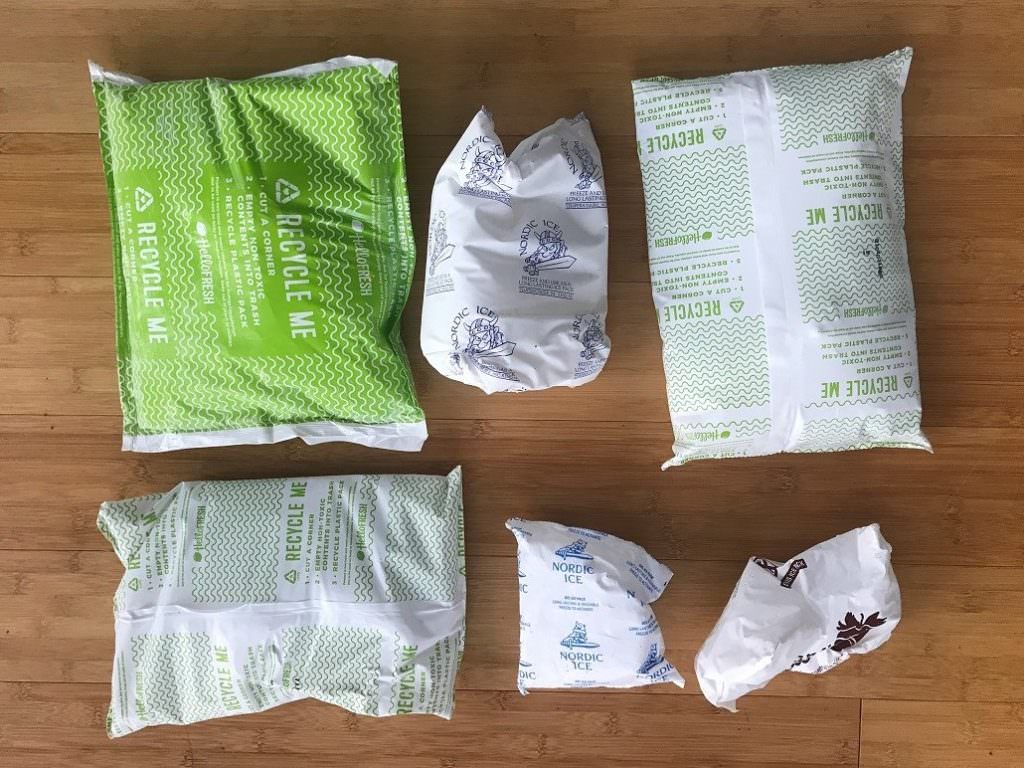If you’re getting your meals delivered, you may already have a collection of cold packs. These gel-filled plastic bags do a great job of keeping perishable food chilled. But what do you do with the cold packs after you’ve unpacked your delivery?
Many of us are turning to meal delivery services instead of eating out. Although these services range from delivering fully cooked meals to providing the ingredients and recipes so you can cook the meal yourself, they have one element in common: The food needs to be cooled to keep it fresh. Gel packs, which stay frozen longer than ice, are the popular solution for food delivery services.
Consisting of sealed, thick plastic bags filled with re-freezable gel, the packs are handy and reusable. But what if you already have more than you can use? Can you recycle them?

Know Your Local Recycling Regulations
Most food delivery companies provide instructions on how to dispose of their packaging. A few even offer a take-back program — which is ideal. Closing the waste loop and making the business responsible for its waste is a sustainability best practice. If you can return the packaging to the company, take full advantage of this option!
Otherwise, study the provided disposal instructions with an open mind. The company may have good intentions but recycling rules and requirements differ by location. Know how your local recycling program works and follow the local recycling guidance.
But before you resort to recycling, consider the reuse and upcycling potential of the cold packs.
Reuse and Donation
Nearly all meal delivery companies tell you to reuse their freezer bags for personal use. That’s fine if you are just an occasional customer. We can all use a few cold packs to fill freezer space. The appliance works harder to cool air than already frozen items, so filling up all space in your freezer is a good practice to minimize your energy use.
Perhaps you could reuse one of these bags as an ice pack when a little one is hurt or when you have a headache or backache. They’re great to use in a cooler when you’re packing food to go. However, if you get meals delivered weekly, your freezer will be filled with cold packs quickly.
You can also pass along these cold packs to nonprofits. Ask around at your local food bank, churches, schools, pre-schools, Meals on Wheels, and any other organization near you that prepares and moves food. Again, this probably isn’t sustainable and you will have an excess of cold packs after a few months.

What To Do With the Goo
Before you recycle the bag, you need to dispose of the gel. Many meal delivery companies direct you to throw away the frozen goo inside their cold packs. I say try to let it air dry first to take up less landfill space. Spill the bag’s contents out onto a baking sheet first and let it dry out overnight, then put it in the trash.
Although your meal delivery company may suggest you put the liquid down the drain, it’s not a good idea. Solid waste districts discourage this practice and it may clog drains.
Some companies say that you may be able to use the liquid contents as a plant fertilizer. This does sound pretty great but be wary of it unless you find out exactly what the contents are. If the manufacturer’s name is printed on the pack, you could try contacting them to request the ingredients. But if you get no response and decide to try it anyway, I’d recommend diluting the goo with water and trying it on a plant you’re not so fond of as a trial. Otherwise, the cold pack gel is not recyclable, so dispose of it in the trash.
Recycling Cold Pack Bags
Good news: The plastic bag is most likely recyclable. In most cases, the shell or envelope for the liquid cold pack is a thick film plastic. After you remove the contents, cut the bag along two or three sides so it can completely dry out before dropping off at your normal plastic film recycling location.
Most grocery stores, big-box retail chains, and mainstream hardware stores offer locations where you can drop off plastic film and bags for recycling. The bags are not recyclable in most curbside pickup municipal programs.
Upcycling
Upcycling the cold packs is also a great option. Consider what you can do with the pack when it’s not frozen. Perhaps you need some padding while packing or need something squishy between delicate stored items in the attic? The packs can be covered with cozy material and used by a tiny dog as a bed (but not used as a cushion for cats, larger dogs, or people since the packs would burst). Ask the kids you know if their dolls could use a trampoline or waterbed. Action figures might make use of squishy sandbags during a fight.
Voice Your Concerns About Packaging
Waste from meal delivery services is often high. We encourage you to pressure your food delivery service to take responsibility for the cold packs and other packaging waste they produce. If enough customers voice their concerns, it can make a difference.
Images courtesy of Maureen Wise
The post Food Delivery Cold Packs: Reuse, Upcycling, & Recycling Tips appeared first on Earth 911.







